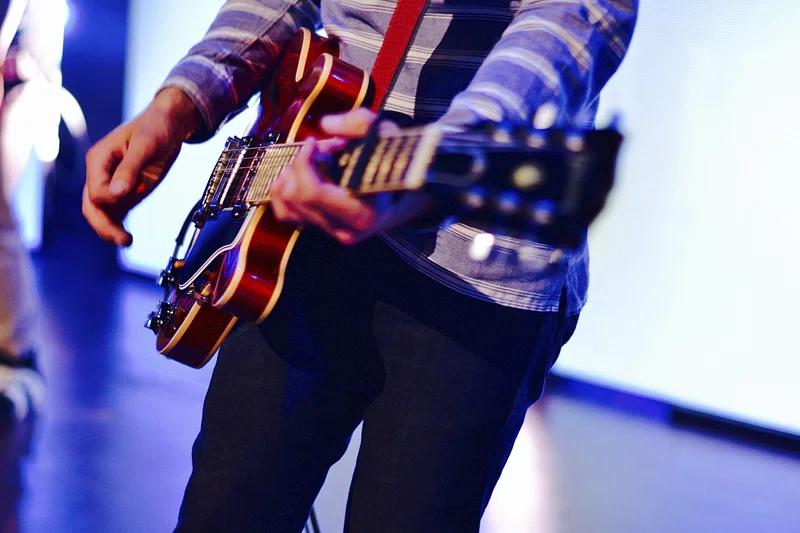If you’ve ever wondered, “why do guitarists change guitars between songs?”, you’re not alone. This common practice in live performances often piques the audience’s curiosity. In this article, we will explore the reasons for this and how it affects the overall show.

Why Do Guitarists Change Guitars Between Songs? – The Reasons
Reason 1: Different Tunings
One of the primary reasons why guitarists change guitars between songs is to accommodate different tunings. Tuning a guitar involves adjusting the tension of each string to reach a specific pitch.
To do this, you have to locate the tuning pegs, which are situated at the headstock of the guitar. Each string is wrapped around its respective peg, and turning the peg either tightens or loosens the string.
Now, you might think, “Why not simply retune the same guitar between songs?” The answer is time and practicality. Retuning a guitar in the middle of a performance can take a couple of minutes, especially if multiple strings need to be adjusted.
Additionally, rapidly changing the tuning can sometimes affect the overall stability of the guitar’s setup. To sidestep these issues, many guitarists have multiple guitars, each pre-tuned to specific requirements for different songs in the setlist. This allows for a smooth transition and helps to maintain the flow and engagement of the performance.
Reason 2: Varied Tone and Sound
Another crucial reason guitarists switch guitars between songs lies in the search for the perfect tone or sound. Different types of guitars are known for producing distinct sounds that cater to various genres and moods.
For instance, a hollow-body electric guitar might offer a deep, resonant tone perfect for jazz or blues, while a solid-body electric guitar could deliver a sharp, bright tone ideal for rock or metal.
To understand the tonal characteristics of each guitar, a guitarist often starts by picking up one guitar and strumming a few chords or perhaps playing a riff or two. They’ll listen carefully to how the guitar responds: the richness of the low notes, the crispness of the high notes, and the overall “color” of the sound.
After this quick evaluation, the guitarist may then switch to another guitar that they know will produce a different tone. They will play similarly to evaluate its sound.
By doing this, they are not just randomly picking instruments but are making an informed choice on which guitar will best serve the sonic needs of each specific song in their performance.
Read more guitar topics here – Guitar Questions: Get the Right Answers to Your Burning Questions
Reason 3: Equipment Malfunction
The live stage environment is dynamic and can be somewhat unpredictable, making equipment malfunction an occasional but inevitable circumstance that musicians must be prepared to address. Now, what sort of malfunctions are we talking about? A string might snap in the heat of a performance.
The pickups — those little rectangles you see under the strings — might suddenly stop working, resulting in a lack of sound. Even the guitar’s electronics might develop a fault, causing tuning instability or other unforeseen issues.
When a guitarist identifies that something is off with their instrument, they have to make a quick but important decision. Should they stop and try to fix the issue on stage, potentially halting the momentum of the show? Most would agree that this isn’t an ideal option. Therefore, a backup guitar becomes a savior in such situations.
This backup is not just any random guitar; it’s usually one that is very similar to the primary guitar, already tuned and equipped with the same settings. The guitarist or a stage tech quickly swaps the malfunctioning guitar with the backup.
Within seconds, the performer is back in action, and the audience may not even realize a switch has occurred. In professional setups, the malfunctioning guitar is then quickly taken backstage for on-the-spot repairs so it can return to the rotation if needed.
This seamless transition ensures that the show goes on, maintaining the energy and engagement level of the performance.
Reason 4: Visual Appeal
Visuals play a huge role in the overall experience of a live performance. It’s not just about the sound; it’s also about the spectacle. And part of that spectacle is the guitar itself.
When a guitarist chooses a guitar for a performance, it’s not just the sound they’re considering but also how it looks under the stage lights, how it contrasts or complements the backdrop, and even how it matches or juxtaposes with their outfit.
Some guitars are iconic for their designs, like the flying V shape, or distinctive colors like a sunburst finish. These visual elements can add another layer of expressiveness to a performance, capturing the audience’s eyes as well as their ears.
Some guitarists take this a step further and may have instruments that are custom-designed with elaborate artwork or unique materials, making them a focal point on stage.
Imagine a moody, soft ballad being played; perhaps a classic-looking, deep-colored acoustic guitar complements the song’s emotions. Now switch your thoughts to an energetic, high-tempo rock song; maybe a flashy, electric guitar with vibrant colors would better suit the mood.
Thus, the visual appeal of the guitar contributes to the storytelling aspect of the performance, amplifying the emotional impact of the music.
When you see a guitarist switch instruments based on the visual elements of the performance, you can appreciate the depth of thought that goes into every detail. Far from a mere aesthetic whim, the choice of guitar can be a calculated decision to elevate the entire concert experience for the audience.
Conclusion: Why Do Guitarists Change Guitars Between Songs?
So, changing guitars between songs is not just a whimsical choice but a practice steeped in necessity and artistry. It can be because of different tunings, varied tonal needs, equipment malfunctions, or even visual appeal.
Knowing this will surely deepen your appreciation for the intricate mechanics that go into producing a seamless musical performance.